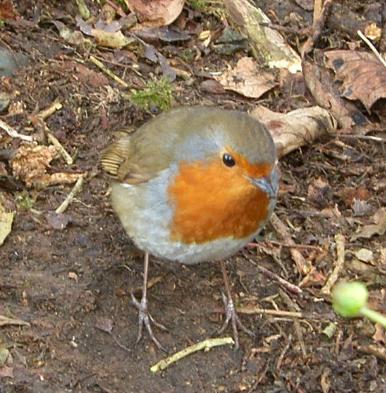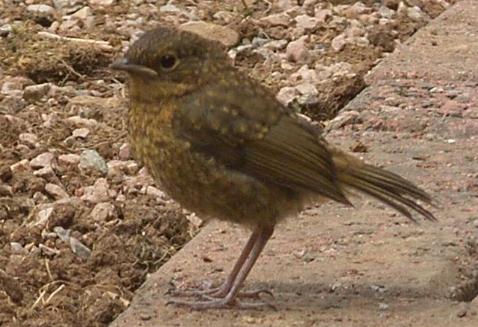European Robin
Scientific name: Erithacus rubecula

'Little Robin red-breast' is the commonest garden bird often becoming very bold as it
follows us around to catch the grubs and seeds turned up as we work. In 2015 the Robin was voted Britain's National Bird with 34% of the 224,000 members of the general public who took part in an unofficial poll. They are more numerous here than on mainland Europe
due to the man-made landscape with lots of hedgerows - robins like the dense, low shrubby cover which the
hedges provide. In autumn some migrate from Scandinavia to Spain
and North Africa via the British Isles, and a few of these migrants remain here through the winter increasing the numbers; they are not so tame and
keep to woodlands.
Modern street lighting can confuse them and they sometimes sing during the night, but
usually the warbling song is heard for most months of the year except in July and August when they are
moulting and keeping a low profile.
Their main foods are insects and worms, but will visit bird-tables for cake, seeds and
mealworms. They do not feed from nut-feeding cages directly, but will mop up the fragments dropped on the
ground as other birds feed. The feeding pattern is similar whether for wild or supplied rations - the robin
sits on a perch cocking its head from side to side for a better view as its eyes face sideways for better all-round vision; then it swoops down to snatch the morsel.
They defend their feeding territory throughout the year, seeing off their own and other
species such as Blue-tits and Hedge Sparrows which have a similar diet. If a threatening display and a loud
alarm call does not work they will engage in physical battle which sometimes becomes so fierce that it leads to a fatality.
Breeding starts in March. Having paired off during the winter the female lays between 3 and 9 white or pale blue, red-speckled eggs. The nest is made from grass and moss, lined with hair and feathers, usually in a hole in a tree or wall, but can be in a roll of netting wire, old pots and kettles. The female incubates the eggs and both parents feed the hatchlings. After about two weeks the young begin to leave the nest. They are brown all over, speckled with dark brown, but paler on the underside, gradually developing their red breast in late summer as they moult.

The American Robin, Turdus migratorius, is found from Alaska to the Gulf of Mexico, but is not the same bird. It is a member of the Thrush family and is much larger. The early European settlers called it a Robin because of the colour of its breast. (In the Disney film of Mary Poppins it is a model of T. migratorius which perches on Julie Andrews' finger as she sings 'A Spoonful of Sugar'). Having said this the sighting of an American Robin was reported recently in London and the street where it was seen was inundated with 'twitchers' who had turned to add it to their list.
Back to GARDEN CREATURES
